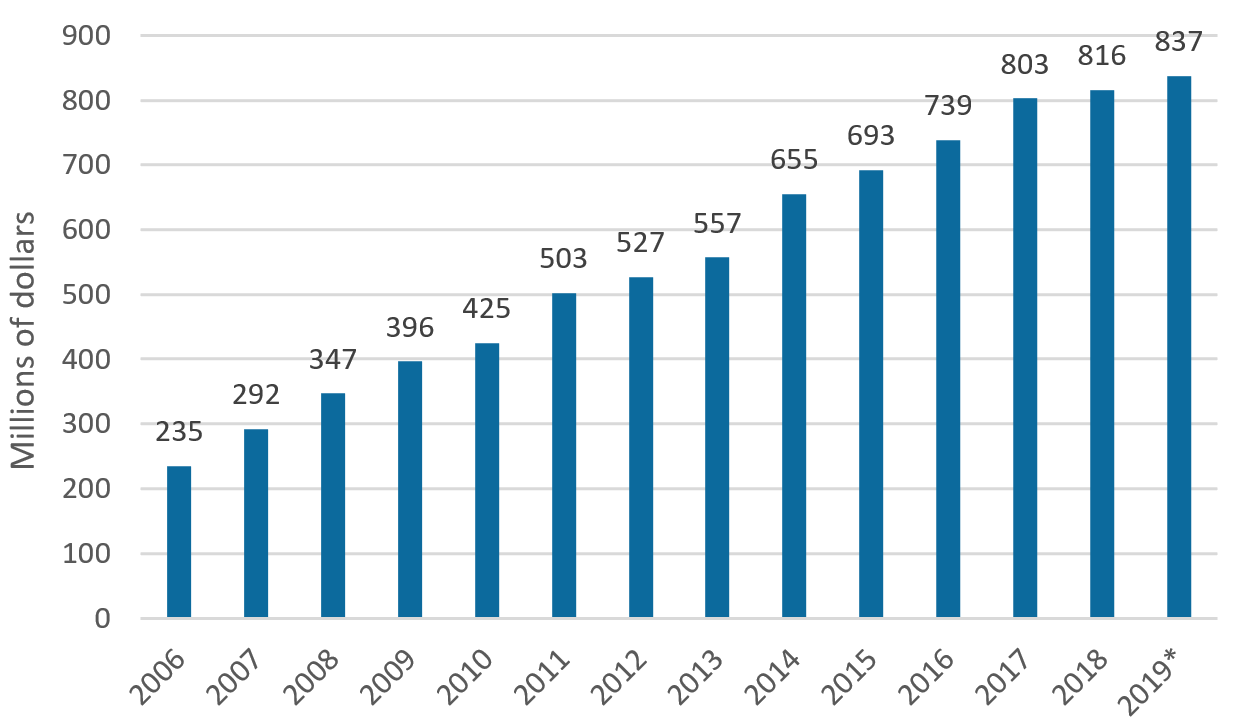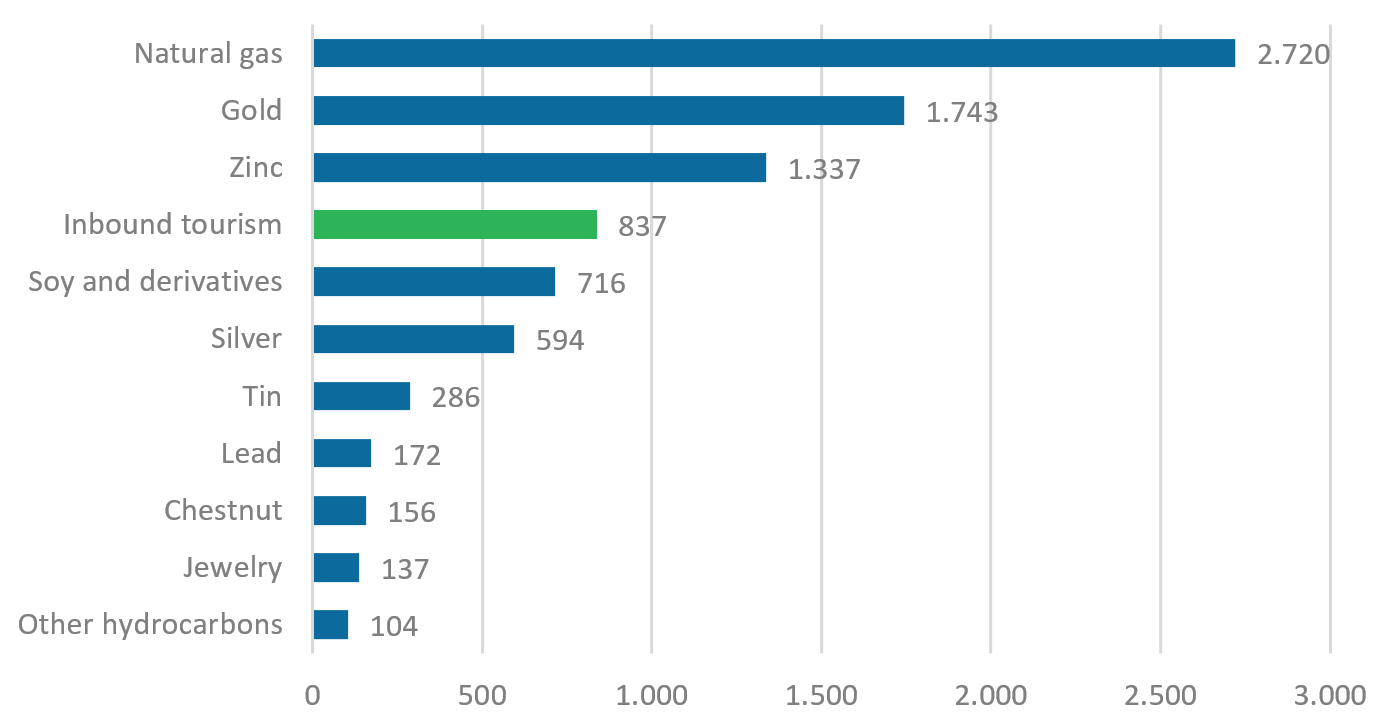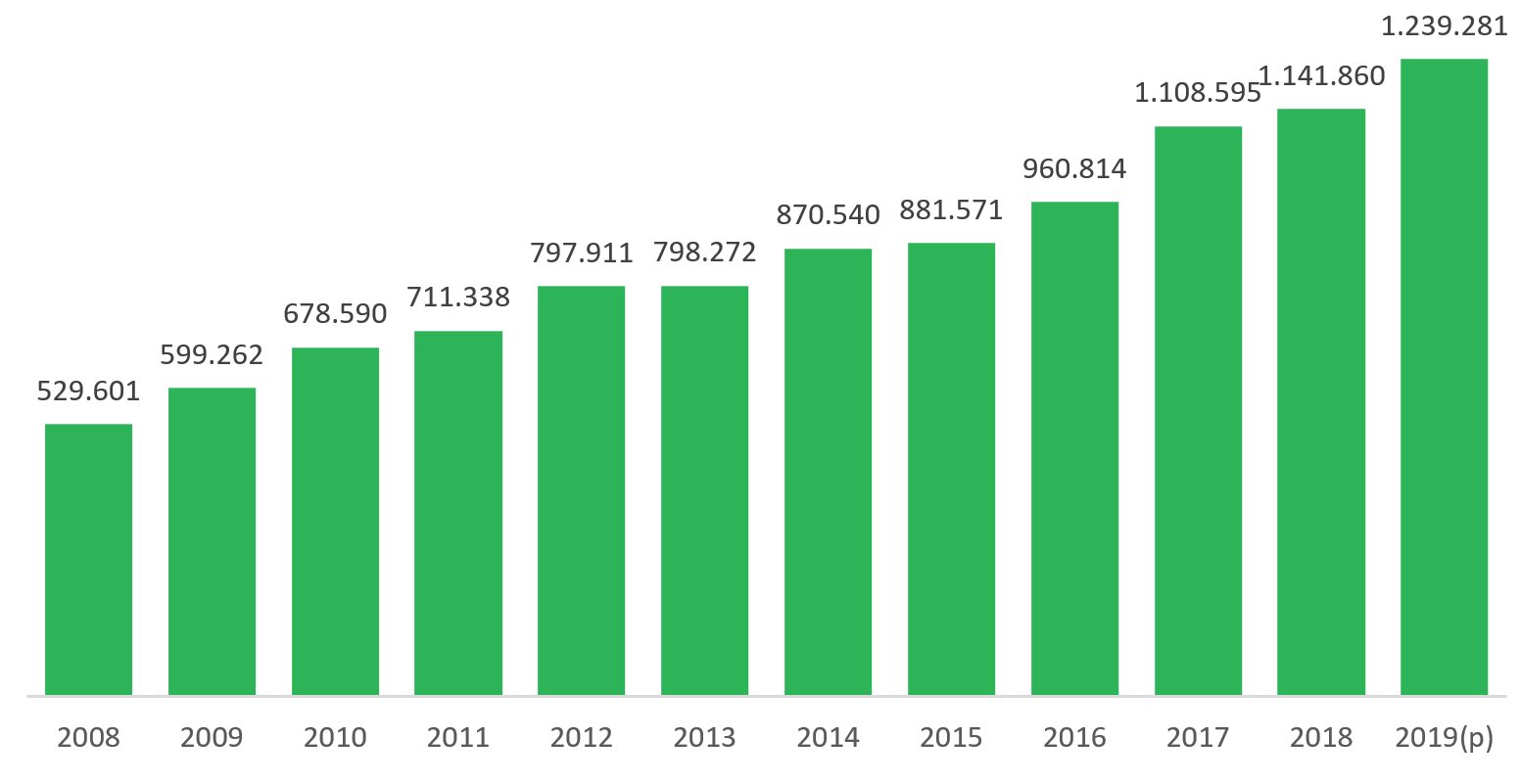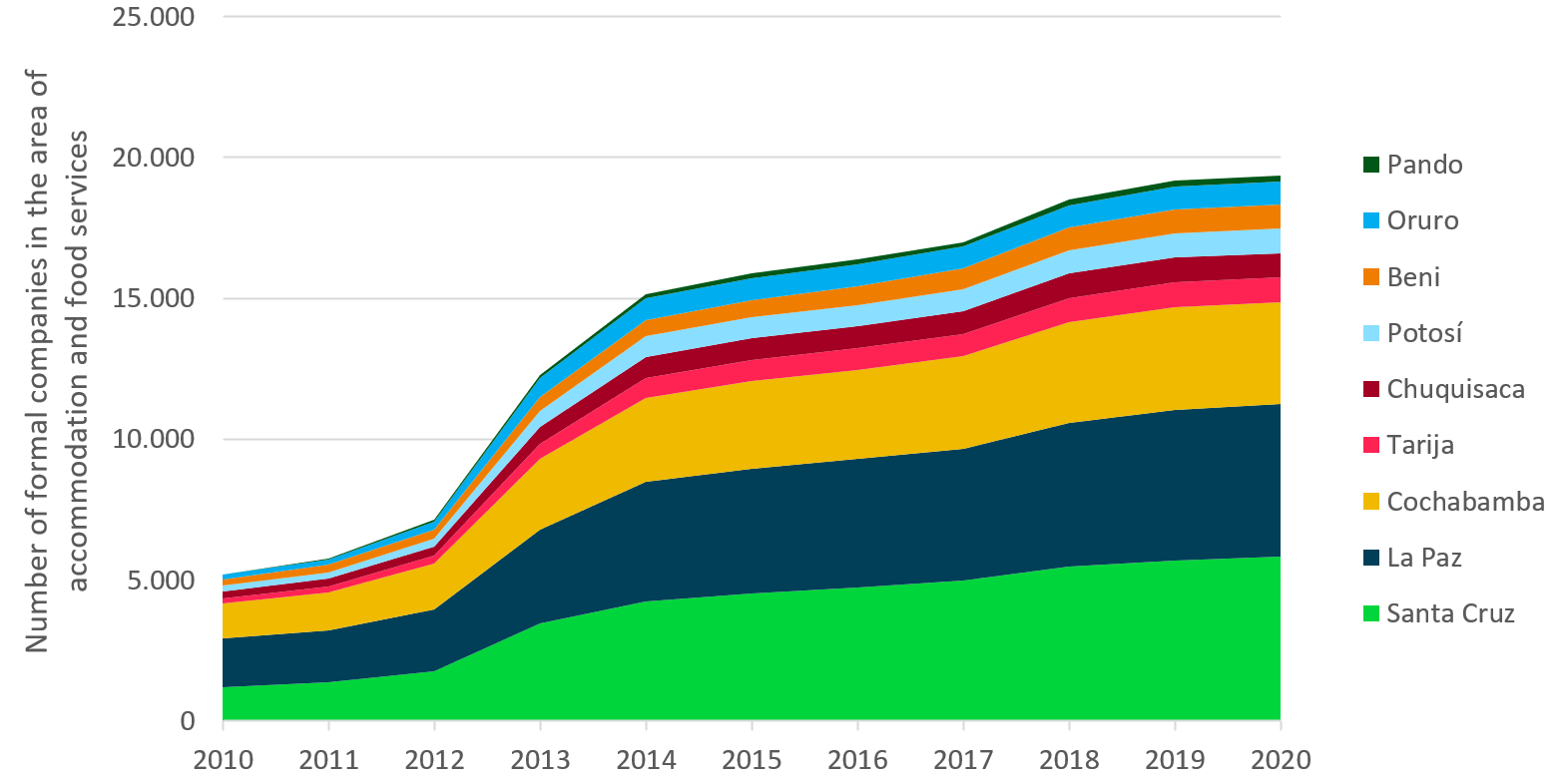December 8th, 2020
Before the pandemic, tourism was one of the fastest growing industries in the world. According to the World Tourism Organization, in 2018 the number of international tourist arrivals worldwide reached 1.4 billion [1]. Likewise, 2018 was the seventh consecutive year where tourism exports growth (+ 4%) exceeded merchandise exports growth (+ 3%). Additionally, the travel and tourism industry accounted for 10.4% of the global GDP, and a similar share in employment
in 2018, showing the industry’s vital role in the global economy.
Tourism in Bolivia
The numbers above show how promising this industry is globally. In the case of Bolivia, despite limited public investment, the outlook is even better. Graph 1 shows that the income generated by inbound tourism in Bolivia has increased at a rate greater than 10% annually between 2006 and 2019.
Graph 1: Spending by foreigner visitors in Bolivia, 2006 – 2019 (millions of dollars)

Source: Authors’ elaboration based on official data from the National Statistics Institute (INE) (https://www.ine.gob.bo/index.php/estadisticas-economicas/turismo/gasto-de-turismo-receptor-y-emisor-introduccion/). Note: Preliminary.
In 2019, international tourism was the fourth most important export product in the country, after natural gas, gold and zinc, and above soy and its derivatives (see Graph 2).
Graph 2: Inbound Tourism Income Compared to Top Ten Export Products, 2019 ($ million)
 Source: Authors’ elaboration based on official data from the National Statistics Institute (INE) (http://web3.ine.gob.bo:8082/comex/make_table.jsp)
Source: Authors’ elaboration based on official data from the National Statistics Institute (INE) (http://web3.ine.gob.bo:8082/comex/make_table.jsp)
Graph 3 shows that the number of foreign visitors has increased from 529,601 in 2008 to 1,239,281 in 2019, which corresponds to an average annual growth rate of 8.0%.
Graph 3: Arrival of foreign visitors to Bolivia, 2008-2019 (number of people)
 Source: Authors’ elaboration based on official data from the National Statistics Institute (INE) (https://www.ine.gob.bo/index.php/estadisticas-economicas/turismo/estadisticas-de-flujo-de-visitantes-introduccion/) Note: Preliminary
Source: Authors’ elaboration based on official data from the National Statistics Institute (INE) (https://www.ine.gob.bo/index.php/estadisticas-economicas/turismo/estadisticas-de-flujo-de-visitantes-introduccion/) Note: Preliminary
Combining the information from Graphs 1 and 3, we calculate that the average spending per foreign visitor rose only slightly from USD 656 to 676 between 2008 and 2019.
According to UDAPE, only 15% of the spending is on accommodation, while 63% is on services such as transportation, food and recreation. The remaining 22% is spent on goods such as souvenirs, handicrafts, clothing and/or gifts [2].
The hotel and gastronomic offers have increased dramatically in the last 10 years. In 2010 there were 5,209 formal companies registered at Fundempresa in the hotels, catering and tourism sector, yet currently this number has almost quadrupled, corresponding to an average annual growth rate of 14%.
The supply has grown faster in Pando and Tarija, but the greatest increase was in Santa Cruz, where 4,636 new companies were established in the area during the last 10 years (see Graph 4).
Graph 4: Number of companies registered in accommodation and food services activities, by department, 2010-2020
 Source: Authors’ elaboration based on data from Fundempresa (https://fundempresa.org.bo/estadisticas/)
Source: Authors’ elaboration based on data from Fundempresa (https://fundempresa.org.bo/estadisticas/)
The investment of private actors in tourism has been carried out in a context in which Bolivia faces both advantages and disadvantages. Among the advantages, the latest Travel and Tourism Competitiveness Report [3] mentions that Bolivia is the country in the region that has improved the most in the Travel and Tourism Competitiveness Index (TTCI) between 2017 and 2019, rising in the ranking from position 99 to 90 out of 140 countries evaluated.
The areas where Bolivia has the most advantages are:
– Natural resources (# 27)
– Cultural resources and business travel (#50)
– Price competitiveness (#61)
On the other hand, Bolivia faces challenges in:
– Human resources and labor market (#114)
– Prioritization of travel & tourism (# 116)
– Ground and port infrastructure (# 127)
– Business environment (#139)
Tourism and the Sustainable Development Goals
The 2030 Agenda mentions tourism in several of the Sustainable Development Goals. In SDG 8 (Decent Work and Economic Growth), Target 8.9 seeks to “devise and implement policies to promote sustainable tourism that creates jobs and promotes local culture and products.” This target exists because the tourism sector is particularly dynamic and transversal, with multiplier effects on different areas such as: the food and beverage industry, textiles, jewelry, handicrafts, transportation, construction, entertainment, and communication. For this reason, it can become a great catalyst of development for local economies.
In Bolivia, tourism already generates more jobs than the mining and natural gas industries combined [4]. It not only generates a wide variety of jobs, compatible with many different types of skills, but it also tends to provide better working conditions than traditional sectors, such as mining or agriculture. Furthermore, in terms of SDG 5 (Achieve gender equality and empower all women and girls), the tourism sector has a lot of potential, since more than 70% of the population employed in tourism are women [4].
The geographical and cultural diversity of Bolivia create potential competitive advantages in the areas of eco-tourism as well as adventure, cultural, and culinary tourism. These types of tourism are characterized by low environmental impacts and well as attention to the well-being of local populations.
For all these reasons, tourism can become a key driver of sustainable development, contributing to economic growth, employment creation, gender equality, and improved living conditions of the local inhabitants through increased coverage of basic services, in addition to promoting environmental protection.
Although tourism is one of the sectors most adversely affected by COVID-19 across the world, the particular characteristics of the type of tourism activities that Bolivia offers (eco-tourism, adventure tourism, extreme sports, etc.) make a quick recovery more likely, as they involve mostly young people being outdoors in nature.
References
[1] World Tourism Organization (2019), International Tourism Highlights, 2019 Edition, UNWTO, Madrid, DOI: https://doi.org/10.18111/9789284421152
[2] Unidad de Análisis de Políticas Sociales y Económicas (2016), Tomo V Turismo. Diagnósticos Sectoriales. En: http://www.udape.gob.bo/portales_html/diagnosticos/diagnostico2018/documentos/TOMO-V-Turismo-10.07.18.html
[3] Calderwood, L. U., & Soshkin, M. (2019). The Travel & Tourism Competitiveness Report 2019. In World Economic Forum. Disponible en línea: http://www3.weforum.org/docs/WEF_TTCR_2019.pdf. Ver también página web interactiva: http://reports.weforum.org/travel-and-tourism-competitiveness-report-2019/rankings/?doing_wp_cron=1607099161.9970541000366210937500#series=TTCI
[4] AnálisisReal-Latinoamérica (2018) El Sistema Económico de los Sistemas Locales: el potencial de los 339 municipios de Bolivia. La Paz, Bolivia: AnálisisReal-Latinoamérica y Fundación Jubileo. Junio.
* SDSN Bolivia.
The viewpoints expressed in the blog are the responsibility of the authors and do not reflect the position of their institutions.

 Español
Español